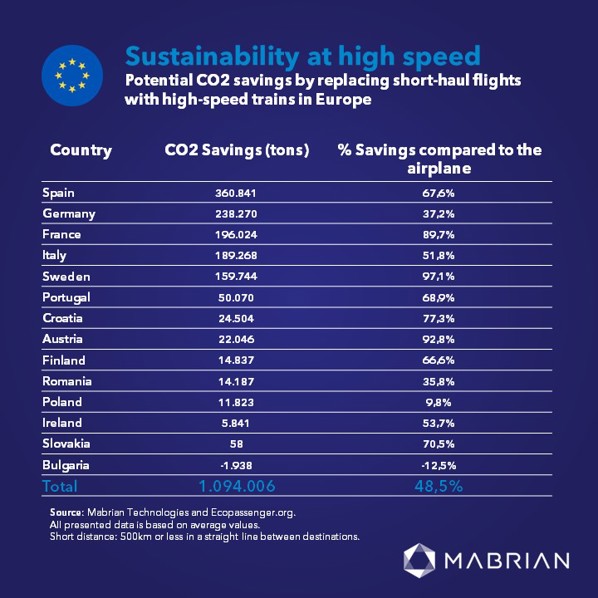The study looked at the potential impact of replacing domestic air routes of less than two and a half hours, and a maximum of 500km, with high-speed trains.
It then analyzed the savings in CO2 emissions if new regulations banning some short-haul domestic flights were to be applied in multiple European countries. In France any journeys that are possible in less than two-and-a-half hours by train cannot be taken as a flight.
According to the report, which analyzed the total air schedule for 2023 on domestic routes with ground distances of less than 500km, there are 554 such routes in Europe, which will carry around 44 million passengers and produce around 2.3 million tons of CO2 this year.
Due to their greater efficiency in terms of emissions, using high-speed trains could reduce this environmental impact by an average of 48%. This would translate into a saving of more than one million tons of CO2 in just one year, which is equivalent to more than 200,000 cars running continuously for 12 months.
For the comparative calculation of emissions, Mabrian has looked at the type of electrical energy and its sources, which power the railway system in each European country, following the methodology published by the EcoPassenger report.
This sets out an ambitious transition toward sustainable mobility, involving the adoption of clean and green technologies. Some countries stand out above others in these policies. Germany, for example, has invested in modernizing its rail infrastructure and adopting cleaner technologies that encourage the use of rail as a more sustainable alternative to air travel, thereby reducing carbon emissions. Sweden has been a pioneer in the use of renewable energy sources such as hydropower and wind power in its rail transport.
The study reveals five of the European countries that would achieve the greatest CO2 savings if this transition were to take place. Spain came out on top, with a potential saving of 360,000 tons of CO2 per year if these routes were replaced by high-speed trains; Germany, in second place, with a saving of 238,000 tons; France, with 193,000 tons; Italy, with 189,000 tons; and Sweden, with 159,000 tons per year.
On the other hand, in relative terms, the three countries with the greatest potential CO2 savings from the transition to rail are Sweden, with 97.13% of the total CO2 produced by aircraft per year; Austria, with 92.79%; and France, with 89.73%. In fact, France has been the pioneer country in applying this measure to short-haul air routes from Orly.
All this analysis has focused only on domestic air routes within each country, so Mabrian indicates that the potential savings would be much greater if all air routes of 500km or less linking different countries in Europe were also considered.
The study also indicates the importance of analyzing several aspects that are not entirely favorable to this change. The cost of implementing the rail infrastructure to cover all these routes would require significant investment, so not all countries may have the resources to finance it. Long-term profitability and the capacity of these new infrastructures to absorb a very significant demand would also have to be considered.
“While this analysis may seem unrealistic or unachievable, at Mabrian we believe in demonstrating the efficiency of decisions through data. With this analysis, we have quantified the potential savings from taking steps in that direction. However, the context and the difficulties of this change suggest an intermediate situation in which the train gains prominence, but aircraft continue to meet part of the demand,” said Carlos Cendra, marketing director at Mabrian.


